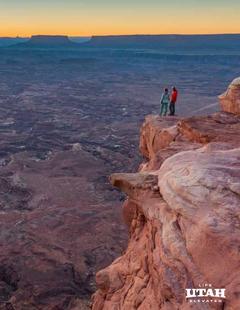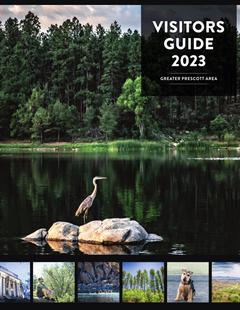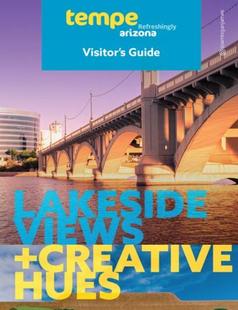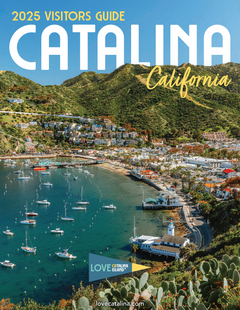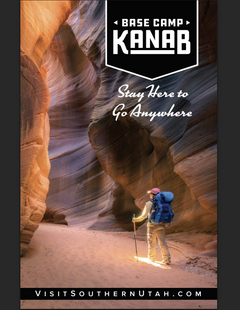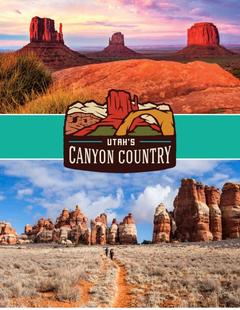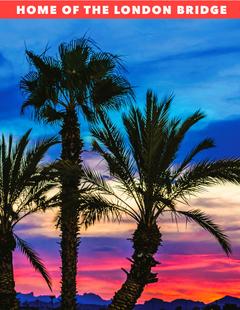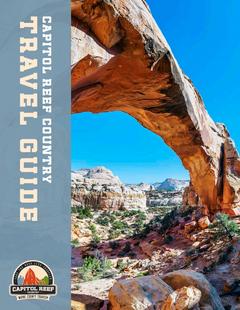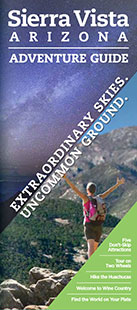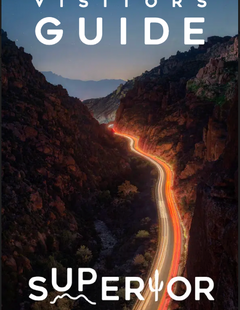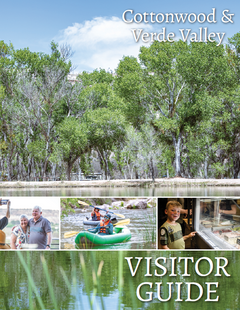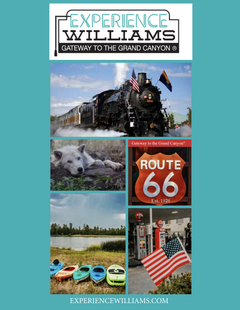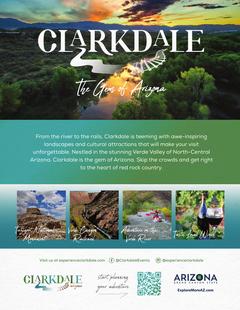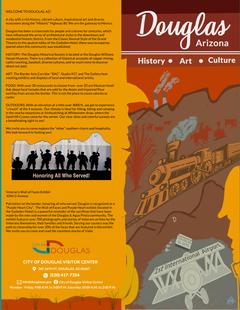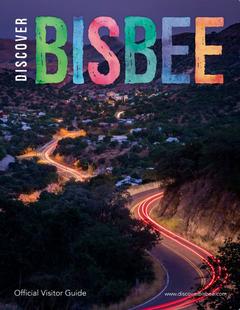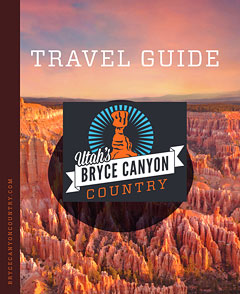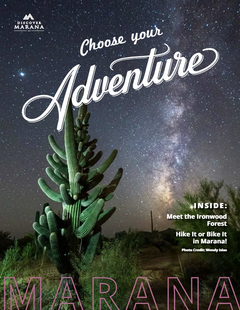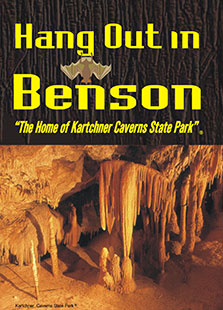Basics
- Length:
- 1410 miles (2269 km)
- Time:
- 5 to 6 days to drive this Byway
Description
"...and they come into 66 from the tributary side roads, from the wagon tracks and the rutted country roads, 66 is the mother road, the road of flight." -- John Steinbeck in "The Grapes of Wrath".
Route 66 means different things to different people, but freedom is a common theme. For families like the Joads, it proved an avenue of escape from dust bowl stricken farms. For troops heading to the battlefronts of World War II, it provided a means to combat world tyranny. For countless American families, it held the promise of a new life out West or an old-fashioned family road trip. Known during its heyday as America's Main Street, this byway holds a special place in the collective consciousness as the herald of a new era of travel.
Decommissioned in 1985, the route is fragmented and sections of it no longer exist. The Mother Road is enjoying a restoration as part of the National Scenic Byways program in Illinois, New Mexico and Arizona, making large portions of the Route 66 adventure easily accessible and well signed. Traveling the route through the states between Illinois and New Mexico is a challenging adventure, so pick up one of the many route-specific guidebooks or maps and hit the road.
During the post-war economic boom, many young people felt restless and disillusioned. They sought solace on the open road away from the big cities and suburbia; pointing their car towards the West and driving with no particular destination. Follow in the path of these bohemian voyagers along the restored sections of this historic Highway. Beginning in Chicago, the Illinois section takes you through the architectural wonders of the metropolitan "windy city" before heading south to the rural farmland of southern Illinois. Along the way you'll stop in at eclectic restaurants and motels, some of which have been around since the route's inception.
For the road-weary traveler, the nation's interstate system tends toward monotony as the same fast food and hotel chains greet you at every exit. Your trip down Route 66 provides a break from the tedium for the cross-country explorer. Evidence of a departure from the routine abounds as you enter New Mexico. Admire the Art Deco "Roadside Attraction." A tribute to the art and architecture you'll find along the Byway, the piece sets the mood for the New Mexico leg of your journey. Stop in at culturally diverse Santa Fe, a hub for artists and southwestern history, to refuel and tuck into some world-class local cuisine.
Natural wonders brought travelers from all over the country to marvel at the desert formations and wildernesses of the Western states. In Arizona, enjoy the natural beauty along the longest section of the original route in the country. Spend some time in Flagstaff, one of the best towns along the byway for reliving the original Route 66 spirit. A hub for such destinations as three national monuments, Sedona's Red Rocks, and the Grand Canyon, Flagstaff is also home to museums, historic mansions, and classic hotels from the 30s to the 60s.
Give yourself a week or so to fully experience the byway, and resist the temptation to think of the end as your goal. Every city along Route 66 offers a little slice of Americana and each mile bears the evidence of kindred adventurous spirits who blazed the trail before you.
Points of Interest
Points of Interest Along The Way
Apache-Sitgreaves National Forest (AZ)
The Sitgreaves National Forest was named for Captain Lorenzo Sitgreaves, a government topographical engineer who conducted the first scientific expedition across Arizona in the early 1850s.
Apache-Sitgreaves National Forest (IL)
The Sitgreaves National Forest was named for Captain Lorenzo Sitgreaves, a government topographical engineer who conducted the first scientific expedition across Arizona in the early 1850s.
Apache-Sitgreaves National Forest (NM)
The Sitgreaves National Forest was named for Captain Lorenzo Sitgreaves, a government topographical engineer who conducted the first scientific expedition across Arizona in the early 1850s.
Canyon de Chelly National Monument (AZ)
Canyon de Chelly (pronounced 'da shay') is one of the longest continuously inhabited places in North America. The ancient ruins of the Anasazi people form the backdrop to the hogans and livestock pens of the Navajo People who live there today. The Canyon is a place of great beauty, boasting deep valleys, colorful ridges & Spider Rock, a thin monolith over 800 feet tall. From the southern rim, hike into the Canyon & visit the White Horse ruins which date back about 1200 years.
Directions
From Lupton's Welcome Center, travel west to US 191. Take US 191 north, passing the Hubbell Trading Post and continue another 30 miles north to the National Monument.
Canyon de Chelly National Monument (IL)
Canyon de Chelly (pronounced 'da shay') is one of the longest continuously inhabited places in North America. The ancient ruins of the Anasazi people form the backdrop to the hogans and livestock pens of the Navajo People who live there today. The Canyon is a place of great beauty, boasting deep valleys, colorful ridges & Spider Rock, a thin monolith over 800 feet tall. From the southern rim, hike into the Canyon & visit the White Horse ruins which date back about 1200 years.
Directions
From Lupton's Welcome Center, travel west to US 191. Take US 191 north, passing the Hubbell Trading Post and continue another 30 miles north to the National Monument.
Canyon de Chelly National Monument (NM)
Canyon de Chelly (pronounced 'da shay') is one of the longest continuously inhabited places in North America. The ancient ruins of the Anasazi people form the backdrop to the hogans and livestock pens of the Navajo People who live there today. The Canyon is a place of great beauty, boasting deep valleys, colorful ridges & Spider Rock, a thin monolith over 800 feet tall. From the southern rim, hike into the Canyon & visit the White Horse ruins which date back about 1200 years.
Directions
From Lupton's Welcome Center, travel west to US 191. Take US 191 north, passing the Hubbell Trading Post and continue another 30 miles north to the National Monument.
Coconino Forest/Arizona Snowbowl (AZ)
The San Francisco Peaks reign as the highest point in Arizona at 12,633 feet. The forest boasts the second largest stand of ponderosa pines in the world. Forest trails offer stunning views of nature at its most breathtaking. The Arizona Snowbowl, with its spectacular views, offers visitors an opportunity to ski in the winter and take a scenic skyride all summer through the changing of the leaves in the fall. On a clear day, you can even get a glimpse of the Grand Canyon.
Directions
From the historic train station on Route 66 in downtown Flagstaff, go west 2 lights. Turn right US 180. Stay on US 180 until you see the turnoff for Snowbowl Road on your right. Follow Snowbowl Road to the lodge.
Coconino Forest/Arizona Snowbowl (IL)
The San Francisco Peaks reign as the highest point in Arizona at 12,633 feet. The forest boasts the second largest stand of ponderosa pines in the world. Forest trails offer stunning views of nature at its most breathtaking. The Arizona Snowbowl, with its spectacular views, offers visitors an opportunity to ski in the winter and take a scenic skyride all summer through the changing of the leaves in the fall. On a clear day, you can even get a glimpse of the Grand Canyon.
Directions
From the historic train station on Route 66 in downtown Flagstaff, go west 2 lights. Turn right US 180. Stay on US 180 until you see the turnoff for Snowbowl Road on your right. Follow Snowbowl Road to the lodge.
Coconino Forest/Arizona Snowbowl (NM)
The San Francisco Peaks reign as the highest point in Arizona at 12,633 feet. The forest boasts the second largest stand of ponderosa pines in the world. Forest trails offer stunning views of nature at its most breathtaking. The Arizona Snowbowl, with its spectacular views, offers visitors an opportunity to ski in the winter and take a scenic skyride all summer through the changing of the leaves in the fall. On a clear day, you can even get a glimpse of the Grand Canyon.
Directions
From the historic train station on Route 66 in downtown Flagstaff, go west 2 lights. Turn right US 180. Stay on US 180 until you see the turnoff for Snowbowl Road on your right. Follow Snowbowl Road to the lodge.
Flagstaff (AZ)
Flagstaff is not only a place to relive the 50s and 60s, it is an ideal hub to experience the Grand Canyon, three national monuments, Sedona's red rocks, and to explore the diverse history of Northern Arizona. Flagstaff's museums, historic mansion, Arboretum and the classic hotels from the 30s-60s that still line Rt 66 are all must-see places to visit.
Flagstaff (AZ)
Flagstaff is not only a place to relive the 50s and 60s, it is an ideal hub to experience the Grand Canyon, three national monuments, Sedona's red rocks, and to explore the diverse history of Northern Arizona. Flagstaff's museums, historic mansion, Arboretum and the classic hotels from the 30s-60s that still line Rt 66 are all must-see places to visit.
Flagstaff (IL)
Flagstaff is not only a place to relive the 50s and 60s, it is an ideal hub to experience the Grand Canyon, three national monuments, Sedona's red rocks, and to explore the diverse history of Northern Arizona. Flagstaff's museums, historic mansion, Arboretum and the classic hotels from the 30s-60s that still line Rt 66 are all must-see places to visit.
Flagstaff (NM)
Flagstaff is not only a place to relive the 50s and 60s, it is an ideal hub to experience the Grand Canyon, three national monuments, Sedona's red rocks, and to explore the diverse history of Northern Arizona. Flagstaff's museums, historic mansion, Arboretum and the classic hotels from the 30s-60s that still line Rt 66 are all must-see places to visit.
Flagstaff (NM)
Flagstaff is not only a place to relive the 50s and 60s, it is an ideal hub to experience the Grand Canyon, three national monuments, Sedona's red rocks, and to explore the diverse history of Northern Arizona. Flagstaff's museums, historic mansion, Arboretum and the classic hotels from the 30s-60s that still line Rt 66 are all must-see places to visit.
Grand Canyon Caverns (AZ)
Since the 1930s, this natural attraction, originally called Dinosaur Caverns, has been a classic Rt 66 tourist stop. These caverns were formed over the course of 35 million years, creating a labyrinth of limestone caves 21 stories beneath the Earth's surface that ultimately vent all theway to the Grand Canyon. The portions of the caverns that the tour goes through could fit 3 football fields. Remains of a mummified bobcat and a 15 ft. sloth are also Cavern attractions.
Grand Canyon Caverns (IL)
Since the 1930s, this natural attraction, originally called Dinosaur Caverns, has been a classic Rt 66 tourist stop. These caverns were formed over the course of 35 million years, creating a labyrinth of limestone caves 21 stories beneath the Earth's surface that ultimately vent all theway to the Grand Canyon. The portions of the caverns that the tour goes through could fit 3 football fields. Remains of a mummified bobcat and a 15 ft. sloth are also Cavern attractions.
Grand Canyon Caverns (NM)
Since the 1930s, this natural attraction, originally called Dinosaur Caverns, has been a classic Rt 66 tourist stop. These caverns were formed over the course of 35 million years, creating a labyrinth of limestone caves 21 stories beneath the Earth's surface that ultimately vent all theway to the Grand Canyon. The portions of the caverns that the tour goes through could fit 3 football fields. Remains of a mummified bobcat and a 15 ft. sloth are also Cavern attractions.
Homolovi Ruins State Park (AZ)
Travelers often overlook this Park which consists of over 300 archaeological sites, including three main sets of Anasazi Indian ruins. The ruins date from the 14th Century and the Hopi Tribe considers the area to be part of their ancestral homeland. The ruins are a sacred site to the Hopi as they believe that the broken pottery and stones are part of theland. The ruins are an archaeological "work in progress" and are a center of research for archaeologists and anthropologists.
Directions
From Rt 66 in Winslow, take SR 87 north to the entrance to the Park.
Homolovi Ruins State Park (IL)
Travelers often overlook this Park which consists of over 300 archaeological sites, including three main sets of Anasazi Indian ruins. The ruins date from the 14th Century and the Hopi Tribe considers the area to be part of their ancestral homeland. The ruins are a sacred site to the Hopi as they believe that the broken pottery and stones are part of theland. The ruins are an archaeological "work in progress" and are a center of research for archaeologists and anthropologists.
Directions
From Rt 66 in Winslow, take SR 87 north to the entrance to the Park.
Homolovi Ruins State Park (NM)
Travelers often overlook this Park which consists of over 300 archaeological sites, including three main sets of Anasazi Indian ruins. The ruins date from the 14th Century and the Hopi Tribe considers the area to be part of their ancestral homeland. The ruins are a sacred site to the Hopi as they believe that the broken pottery and stones are part of theland. The ruins are an archaeological "work in progress" and are a center of research for archaeologists and anthropologists.
Directions
From Rt 66 in Winslow, take SR 87 north to the entrance to the Park.
Hopi Indian Reservation (AZ)
The Hopi Reservation encompasses approximately 1,542,306 acres. TheReservation consists of three major mesas rising up to 7,200 feetsurrounded by low altitude deserts and gullies. The Hopi People areconsidered the oldest of today's native people, and the western-most Hopipueblo is the oldest continuously inhabited US settlement. The land isfilled with colorful rock formations, mesas and buttes. Keams Canyon,and Second Mesa Cultural Center are a must for tourists.
Directions
From Rt 66 in Winslow, travel north on SR 87 about 45 miles to Second Mesa on the Hopi Reservation.
Hopi Indian Reservation (IL)
The Hopi Reservation encompasses approximately 1,542,306 acres. TheReservation consists of three major mesas rising up to 7,200 feetsurrounded by low altitude deserts and gullies. The Hopi People areconsidered the oldest of today's native people, and the western-most Hopipueblo is the oldest continuously inhabited US settlement. The land isfilled with colorful rock formations, mesas and buttes. Keams Canyon,and Second Mesa Cultural Center are a must for tourists.
Directions
From Rt 66 in Winslow, travel north on SR 87 about 45 miles to Second Mesa on the Hopi Reservation.
Hopi Indian Reservation (NM)
The Hopi Reservation encompasses approximately 1,542,306 acres. TheReservation consists of three major mesas rising up to 7,200 feetsurrounded by low altitude deserts and gullies. The Hopi People areconsidered the oldest of today's native people, and the western-most Hopipueblo is the oldest continuously inhabited US settlement. The land isfilled with colorful rock formations, mesas and buttes. Keams Canyon,and Second Mesa Cultural Center are a must for tourists.
Directions
From Rt 66 in Winslow, travel north on SR 87 about 45 miles to Second Mesa on the Hopi Reservation.
Hualapai/Havasupai Reservation (AZ)
The name "Hualapai" (pronounced Wala pie) means People of the Tall Pines. These People, as well as the Havasupai, have occupied this land for more than 800 years. The Reservations hug the Grand Canyon on their northern limits. South from Peach Springs you can drive to the Colorado River for rafting or head north 65 miles to the Havasupai Reservation where a 13-mile hike will take you to a series of impressive waterfalls or 18 miles to Supai Village on Havasu Creek.
Hualapai/Havasupai Reservation (IL)
The name "Hualapai" (pronounced Wala pie) means People of the Tall Pines. These People, as well as the Havasupai, have occupied this land for more than 800 years. The Reservations hug the Grand Canyon on their northern limits. South from Peach Springs you can drive to the Colorado River for rafting or head north 65 miles to the Havasupai Reservation where a 13-mile hike will take you to a series of impressive waterfalls or 18 miles to Supai Village on Havasu Creek.
Hualapai/Havasupai Reservation (NM)
The name "Hualapai" (pronounced Wala pie) means People of the Tall Pines. These People, as well as the Havasupai, have occupied this land for more than 800 years. The Reservations hug the Grand Canyon on their northern limits. South from Peach Springs you can drive to the Colorado River for rafting or head north 65 miles to the Havasupai Reservation where a 13-mile hike will take you to a series of impressive waterfalls or 18 miles to Supai Village on Havasu Creek.
Hubbell Trading Post National Historic Site (AZ)
Founded in 1878, ten years after the Navajo repatriation, John L. Hubbell's Trading Post is the oldest continuously operated trading post on the Navajo Nation. Over the years the Navajo people acquired tastes for things that were alien to their culture. Hubbell traded these items for Navajo goods such as blankets, pottery, and jewelry. A non-profit organization now operates the trading post, maintaining the trading traditions set through generations.
Directions
Take US 191 from I-40 north. The Hubbell Trading Post is located on Highway 264 in Ganado, AZ.
Hubbell Trading Post National Historic Site (IL)
Founded in 1878, ten years after the Navajo repatriation, John L. Hubbell's Trading Post is the oldest continuously operated trading post on the Navajo Nation. Over the years the Navajo people acquired tastes for things that were alien to their culture. Hubbell traded these items for Navajo goods such as blankets, pottery, and jewelry. A non-profit organization now operates the trading post, maintaining the trading traditions set through generations.
Directions
Take US 191 from I-40 north. The Hubbell Trading Post is located on Highway 264 in Ganado, AZ.
Hubbell Trading Post National Historic Site (NM)
Founded in 1878, ten years after the Navajo repatriation, John L. Hubbell's Trading Post is the oldest continuously operated trading post on the Navajo Nation. Over the years the Navajo people acquired tastes for things that were alien to their culture. Hubbell traded these items for Navajo goods such as blankets, pottery, and jewelry. A non-profit organization now operates the trading post, maintaining the trading traditions set through generations.
Directions
Take US 191 from I-40 north. The Hubbell Trading Post is located on Highway 264 in Ganado, AZ.
Lowell Observatory (AZ)
The planet Pluto was discovered at this observatory and remains the only planet discovered in the US. This working observatory was founded in 1894 by Percival Lowell, a mathematician and amateur astronomer, for the purpose of mapping the canals & geographical features of Mars. In1930, Clyde Tombaugh, acting on Lowell's theories, discovered "Planet X", later named Pluto. The Clark telescope used in the discovery along with 100s of artifacts are on display at the Observatory.
Directions
From the historic Flagstaff train station on Rt 66, head west past City Hall where you pick up Santa Fe Ave. Santa Fe turns into Mars Hill which leads you up to the Lowell Visitor Center.
Lowell Observatory (IL)
The planet Pluto was discovered at this observatory and remains the only planet discovered in the US. This working observatory was founded in 1894 by Percival Lowell, a mathematician and amateur astronomer, for the purpose of mapping the canals & geographical features of Mars. In1930, Clyde Tombaugh, acting on Lowell's theories, discovered "Planet X", later named Pluto. The Clark telescope used in the discovery along with 100s of artifacts are on display at the Observatory.
Directions
From the historic Flagstaff train station on Rt 66, head west past City Hall where you pick up Santa Fe Ave. Santa Fe turns into Mars Hill which leads you up to the Lowell Visitor Center.
Lowell Observatory (NM)
The planet Pluto was discovered at this observatory and remains the only planet discovered in the US. This working observatory was founded in 1894 by Percival Lowell, a mathematician and amateur astronomer, for the purpose of mapping the canals & geographical features of Mars. In1930, Clyde Tombaugh, acting on Lowell's theories, discovered "Planet X", later named Pluto. The Clark telescope used in the discovery along with 100s of artifacts are on display at the Observatory.
Directions
From the historic Flagstaff train station on Rt 66, head west past City Hall where you pick up Santa Fe Ave. Santa Fe turns into Mars Hill which leads you up to the Lowell Visitor Center.

















